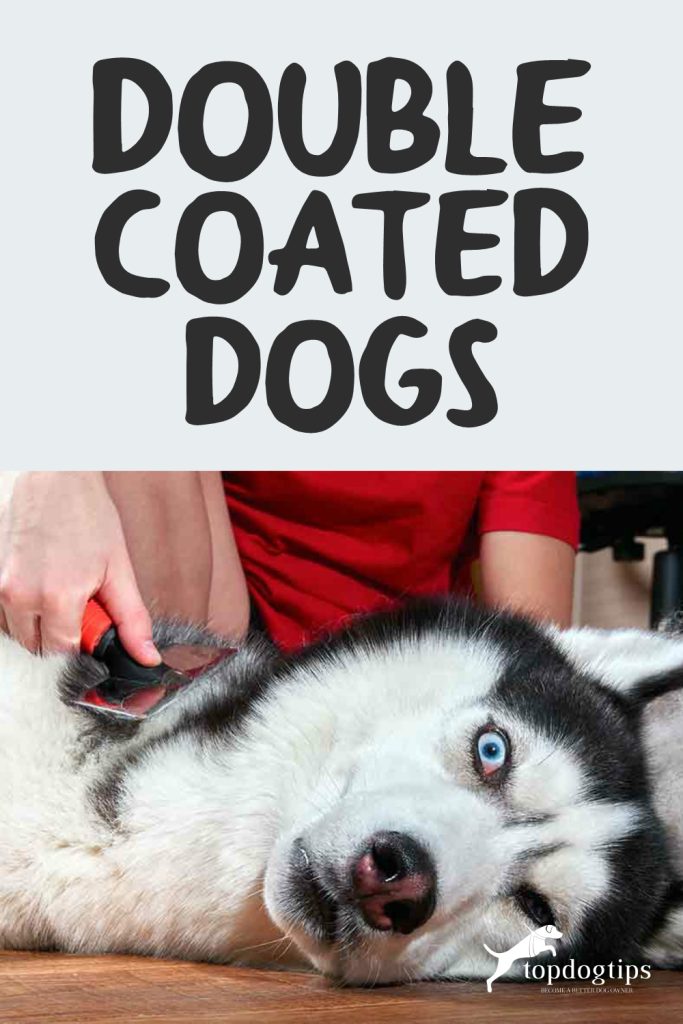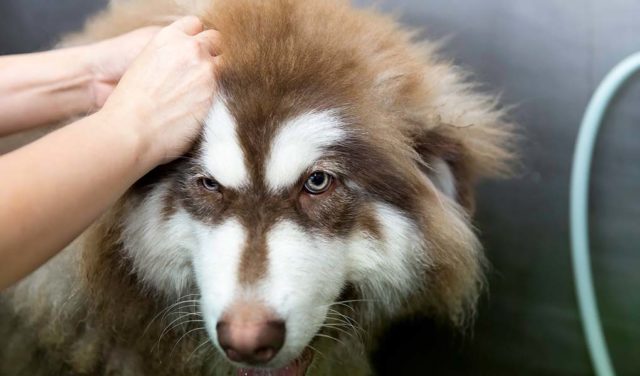
Table of Contents
- How to Tell Double-Coated Dogs from Others
- 38 Double-Coated Dog Breeds
- Akita
- Alaskan Husky
- Siberian Husky
- Alaskan Malamute
- Chow Chow
- Finnish Lapphund
- Keeshond
- Shiba Inu
- Australian Shepherd
- German Shepherd
- English Shepherd
- Polish Lowland Sheepdog
- Old English Sheepdog
- Shetland Sheepdog
- Bernese Mountain Dog
- Great Pyrenees
- Newfoundland
- Chesapeake Bay Retriever
- Nova Scotia Duck Tolling Retriever
- Golden Retriever
- Labrador Retriever
- Beagle
- American English Coonhound
- Border Collie
- Rough Collie
- Smooth Collie
- Bearded Collie
- Cairn Terrier
- Parson Russel Terrier
- Scottish Terrier
- Wirehaired Fox Terrier
- Welsh Corgi
- Pembroke Corgi
- Miniature Schnauzer
- Havanese
- Pomeranian
- Shih Tzu
- Double-Coated Dogs: Importance
- Double-Coated Dogs: How to Groom Them?
- Double-coated Dogs: FAQs
One of the first breeds that come to mind when people hear about double-coated dogs is the Huskies.
And while that’s a fitting response, not all double-coated breeds look the same as Huskies.
Here's everything you should know about double-coated dogs, which ones are and aren't, and how to groom them.
Every specified class of canines has at least one or more double-coated dog breeds, meaning it isn’t just large canines – like the Husky – but also petite pups who have double coats.
Some breeds with a double coat can appear quite sleek, such as Beagles, a popular pet known for its hunting skills and Snoopy-fame more so than its coat.
With such a vast list of double-coated dogs, it can sometimes be difficult for the untrained eye to spot one, but it's important that you know whether the dog is or isn't double-coated.

How to Tell Double-Coated Dogs from Others
A dog with a double coat will have some defining, unique characteristics:
Possible dewlap
A dewlap is characterized by extra skin around the neck of a dog.
This is common in working and hunting breeds, particularly if their origins are from colder regions, because it serves as added insulation.
Not all double-coated dogs have a dewlap, but many dogs with dewlaps also have a double coat.
Seasonal shedding
Seasonal shedding differentiates from other forms of shedding in dogs by only occurring early to late spring to prepare the animal for the summer heat.
However, seasonally-shedding double coats do not suggest that shedding only occurs for a few months annually, but rather that it occurs in a higher frequency (especially if their grooming routine isn’t attended to).
Additionally, double-coated dogs living in a climate that’s warmer year-round are likely to shed by the weather and thus shed all year long.
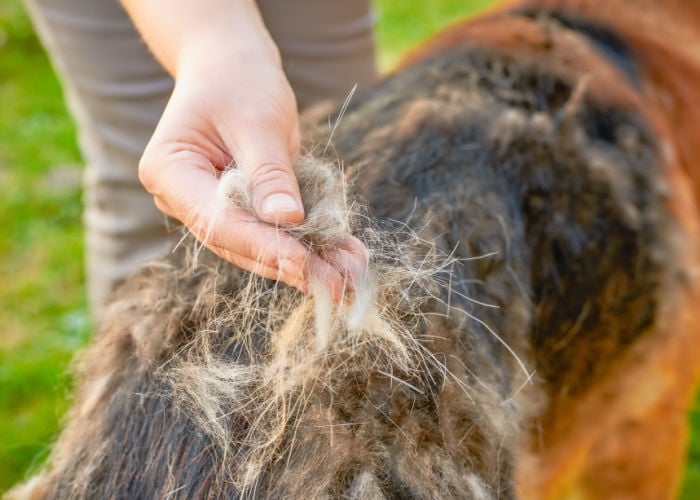
Medium to the long outer layer of hair
The dog's coat's length or “shagginess” varies by breed, but most double-coated dogs have a fluffier appearance.
There are also dogs with double coats with wiry hair, many of which we see in the Terrier breed.
Presence of a topcoat
The topcoats will have different appearances, varying from breed to breed among double-coated dogs.
Most people associate the topcoat with an unruly shagginess or fluffiness; however, it can be short and sleek, which is seen with the American English Coonhound, for example.
Topcoats also help protect against moisture, keeping a dog’s core temperature warmer during rain or snow.
This topcoat is also referred to as guard hair. It benefits bird hunting and retrieving breeds by allowing them to work through water without getting too weighed down or cold due to becoming wet.
Presence of an undercoat
The undercoat is a bedding of insulating fluff that regulates temperature, keeping the dog warm in chilly weather and cool in warmer weather.
It's common for double-coated dog breeds to have undercoats, and it needs routine grooming attention in the form of brushing and bathing.
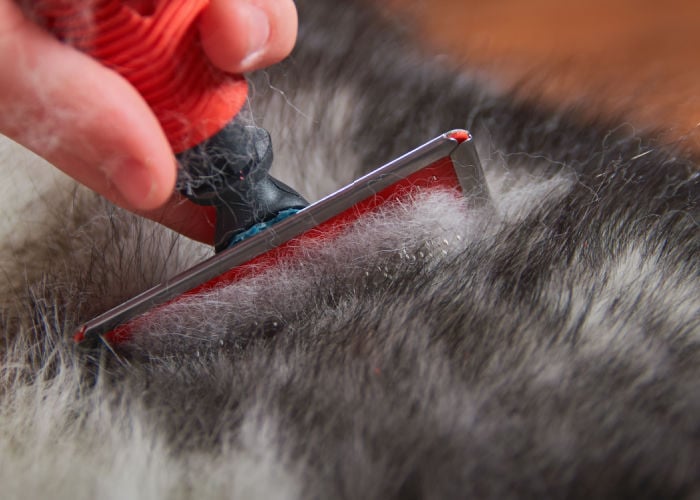
38 Double-Coated Dog Breeds
Now that you know how to distinguish double-coated dog breeds from others, here's a cheat sheet of the most common double-coated dogs you've probably encountered:
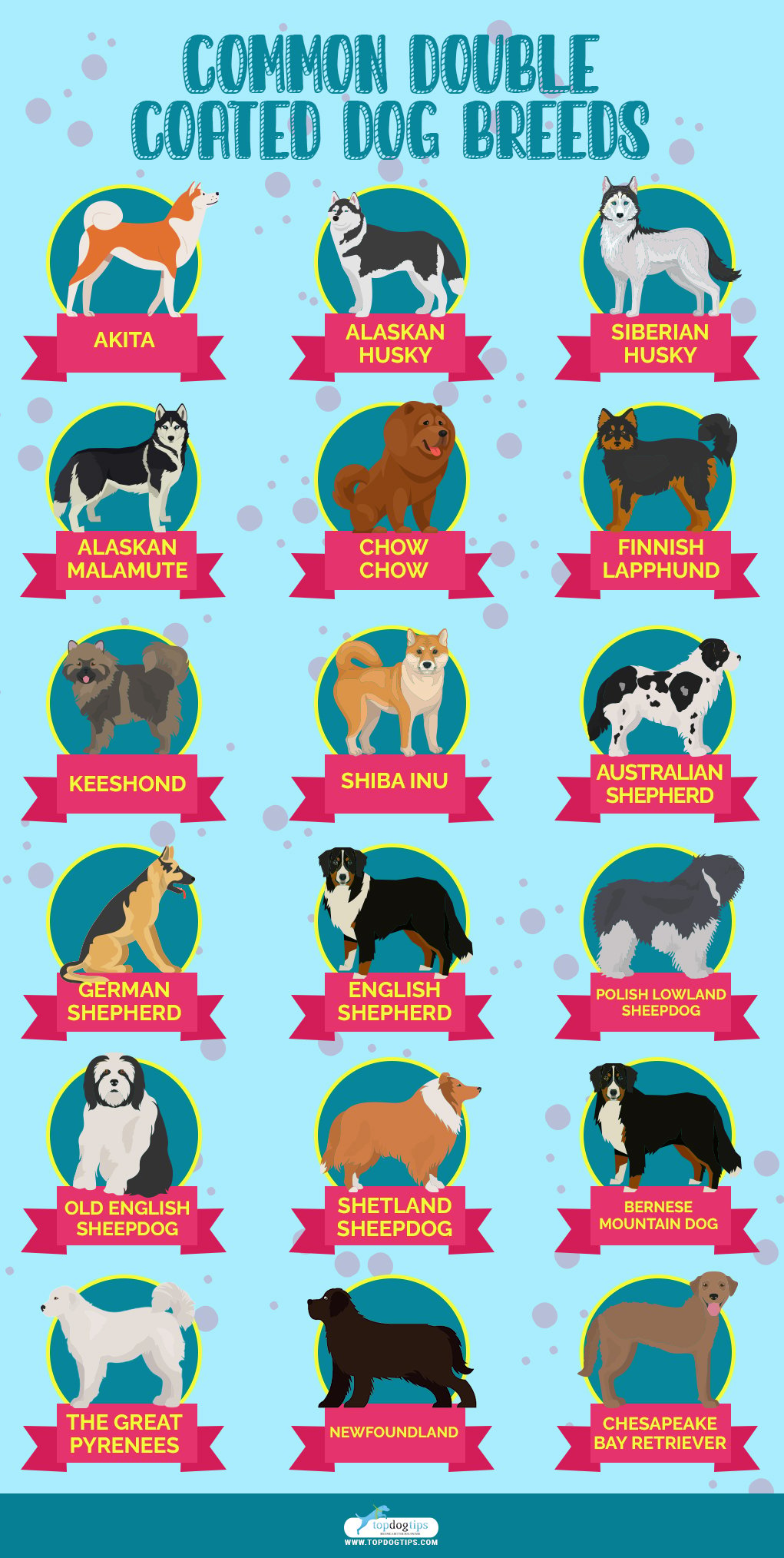
Akita
The double coat of this breed is made up of a thick underneath layer and a straight, coarse outside hair that protrudes from the body.
It has dual, short fur it shares with several other northern spitz breeds.
Alaskan Husky
The breed's silky undercoat lies deeply behind its straight guard furs.
It is renowned for having thick hairs that keep it warm in the coldest regions.
Siberian Husky
This breed's undercoat is extremely dense and soft, while the top layer is thicker and straighter, protecting it from the harsh Arctic seasons.
The tail and legs lack long fringes, although there is a little ruff around the neck.
Alaskan Malamute
The entire body of this breed is covered in an oily, woolly undercoat at skin level and is shielded from the elements by rough guard hair.
It can endure both rain and cold weather owing to its thick layers.
Chow Chow
This breed’s furs are woolly underneath and coarse and medium in length on top.
Its curled tail bobs and is naturally fluffy.
Finnish Lapphund
This breed has a thick double coat that splits into a short, feathery underneath layer and longer guard hairs.
The fur is both water- and cold-resistant.
Keeshond
This breed has a long guard coat and a woolly underneath layer.
The base hairs are light gray or cream in color, and the guard layers are a mix of gray and black.
Shiba Inu
This breed’s undercoat is rich and fluffy, but its outer furs are straight and stiff.
It resembles a Teddy Bear due to its thick dual coating.
Australian Shepherd
An undercoat that is dense and fluffy and a rougher outside furs make up this breed's dual hair layers.
The rear of their legs are feathered, with a thick mane around their necks.
German Shepherd
This breed has lustrous furs on the outside and a fluffy, duller coat inside.
There are two acceptable lengths for the hairs: medium and long.
English Shepherd
This breed's outer furs are dirt- and weather-resistant, while its soft undercoat experiences seasonal shedding.
Its mane might have a straight, wavy, or even curly texture.
Polish Lowland Sheepdog
The underneath layer of this breed is silky and dense, and the outer hairs are sharp and water-resistant in texture.
Old English Sheepdog
This breed's furs comprise a thick undercoat that keeps it dry and a longer, stronger-resistant top layer.
It is quickly identifiable, attributed to its thick, layered hairs.
Shetland Sheepdog
The short, dense underneath layer of this breed makes the longer, rougher topcoat protrude from the body.
The tail and legs are feathered, and the mane is richly frilled.
Bernese Mountain Dog
The furs underneath this breed are often short and woolly in texture, while its top layer has long hairs.
It benefits from additional ground hair insulation, while the guard coat is a barrier to keep out dirt and moisture.
Great Pyrenees
This breed has dual hair layers, a long guard coat, and a supple underneath layer.
Despite having a lot of furs, this breed doesn't need a lot of grooming as the hair resists dirt and tangles.
Newfoundland
This breed has a dense, dual coat comprising a soft, dense undercoat and coarse, wavy outside hairs.
The furs are quite oily and, therefore, waterproof.
Chesapeake Bay Retriever
This short-haired breed has rough, water-resistant outer hair and a plush, woolly undercoat.
While it does shed, it doesn't need regular upkeep or bathing.
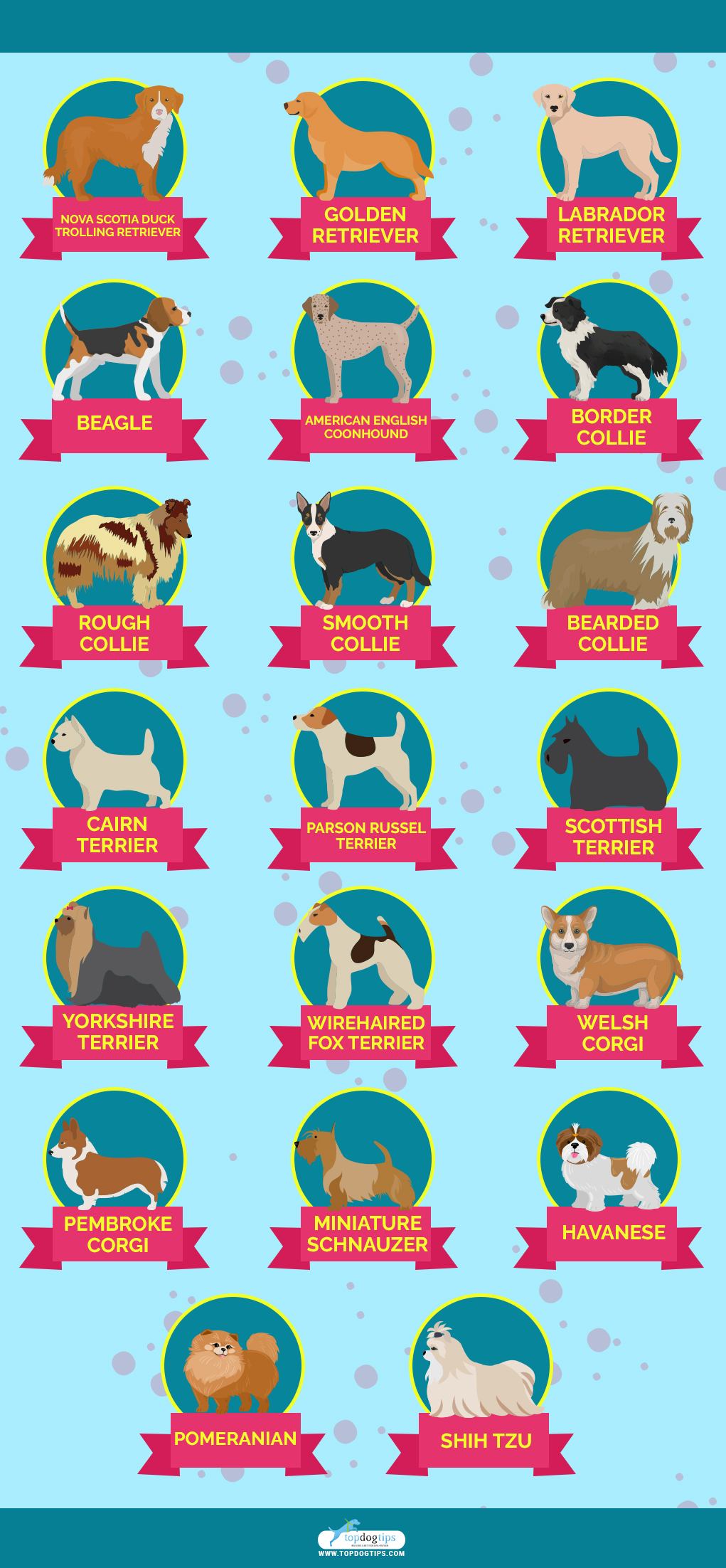
Nova Scotia Duck Tolling Retriever
To retrieve from freezing waters, this breed must have a waterproof double coat of medium length and softness, as well as a supple, rich underneath layer.
Golden Retriever
A long, coarse top hair covers this breed's soft, fuzzy undercoat.
In all weather situations, these two layers serve as an insulator.
Labrador Retriever
This breed has an underlying thick and silky fur that protects the skin from moisture and cold.
The thick, hard coat comes in rich chocolate, black, and yellow colors.
Beagle
This breed has a soft and dense undercoat, while its guard layer comprises highly water-repellent coarse hairs.
It has sporadic white coatings that alternate with brown patches.
American English Coonhound
This breed stands out by its solid, double-coated, medium-length hair.
Its skin and fur are kept hydrated by natural moisturizing elements.
Border Collie
This breed’s coat comprises a longer, water-resistant guard layer and a soft, thick undercoat.
Its hair sheds periodically to rejuvenate the fur and is nature’s way of keeping it cool.
Rough Collie
Long, flatter, thinner coats and a thicker, smoother undercoat are characteristics of this breed.
The shedding happens all year, but it gets much worse when it “blows” its coats in the spring and fall.
Smooth Collie
This breed’s hairs comprise a soft, rich ground layer and a straight, coarse guard coat.
The guard hairs are about an inch and two centimeters long, with the longer hair mostly in a ruff on the backs of the thighs and around the neck.
Bearded Collie
This breed has a soft undercoat with a flat, rough, long outer coat that gives it its recognizable “shaggy dog” appearance.
The hairs are fuller on its chin and cheeks.
Cairn Terrier
The ground layer hairs of this breed are short, soft, and dense, while the guard coat is thick, rough, and wiry.
The furs insulate well and repel weather and dirt.
Parson Russel Terrier
This breed can have a rich undercoat and rough, broken, or smooth guard hairs.
Its dual-layer coat could combine smooth and dry (wiry) features.
Scottish Terrier
This breed has a deep, soft underneath hair layer within its rough, wiry outer covering, making it a dual-coated breed.
Both the undercoat and the guard furs can be brindle-striped, wheaten yellow, or any combination of those colors.
Wirehaired Fox Terrier
This breed has a soft, dense undercoat underneath its rough, wiry guard furs.
The wire’s main color should be white, with black and brown markings.
Welsh Corgi
The double coat of this breed makes it weatherproof.
Rich fawn, red, or black with white markings are all possible shades of color.
Pembroke Corgi
The coat of this breed has two layers: guard hairs that provide extra defense and a layer underneath that is supple and keeps it warm.
It sheds a lot all year round, with spring and fall being their greatest periods.
Miniature Schnauzer
The top coat of this breed is stiff and wiry, whereas the underneath layer is plush.
It may be a dog suitable for allergy sufferers because of its double coats’ minimal care and low shedding characteristics.
Havanese
A long outer coat and an undercoat are features of this breed.
Due to the coat’s likeness to fine silk, this dog has been referred to as the “Havanna silk dog.”
Pomeranian
This breed’s hairs have a long top layer and a short, interior layer.
The undercoat supports the much longer guard furs and has small, light, and fluffy soft hairs that provide insulation.
Shih Tzu
This breed’s furs comprise a ground layer of shorter, softer hair and a guard layer of longer hair.
It is renowned for changing the color of its coat as it grows older.
Double-Coated Dogs: Importance
While all dogs have natural oils and even bacteria that reside on their skin and fur to help keep them healthy and clean, double-coated dogs have the added advantage of extra insulation.
Single-coated canines also benefit from insulation, but it’s more comparable to a light fall jacket than to a heavy winter coat.
Many double-coated dog breeds originated from regions known for frigid temperatures.
In contrast, double coats of the hunting breed benefit from added protection should they have a close encounter with what’s being hunted.
However, all these benefits for the dog mean extra work for the owner when it comes to grooming double-coated dogs.
Double-Coated Dogs: How to Groom Them?
There’s some controversy surrounding grooming double-coated dogs, as many pet owners are not educated on the proper grooming methods.
Do NOT shave a double-coated dog
For example, a family may live in Florida but own an Alaskan Malamute and believe they’re helping their furry companion to stay cool in the humid, tropical climate by shaving him. It's a mistake.
Shaving a double-coated dog not only destroys the natural beauty and texture of the dog’s coat, as it will never grow back the same, but it also exposes the dog to harmful ultraviolet rays from the sun.
The double coat is there for a reason.
While it’s true that the thick double coat insulates, trapping body heat close and keeping dogs warm in cold weather, it’s also true that the coat helps keep them cool by protecting their skin from the sun.
We may retreat under an umbrella or shade to avoid sun exposure and damage, but the canine double-coated breed lives its life with built-in armor.
After shaving double-coated dogs, their “armor” is harmed, sometimes beyond repair, and their previously long, compacted coat is no longer there to shield sensitive skin from UV damage and heat.
This puts double-coated dogs in danger of sunburn and overheating, a serious condition that can be fatal if unacknowledged. Overheating is especially worrisome for young puppies or dogs with a high-energy drive.
The more activity they endure, the hotter they become, sometimes playing to the point of complete exhaustion.
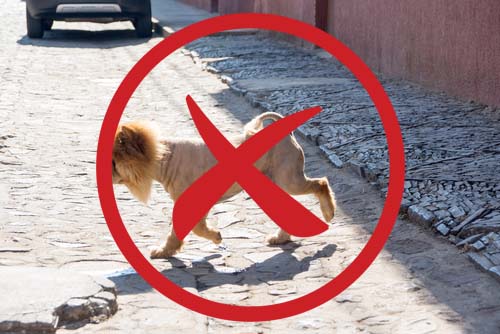
Brush double-coated dogs regularly
Besides dogs shedding themselves, brushing them is an ideal way to remove dead hair from the coat.
Releasing dead hair allows new, healthy growth to occur in the hair follicles, and the healthier a double coat, the better it is at regulating temperature.
This is even more important for double-coated dog breeds due to more hair on them.
Double-coated dog breeds without weekly (some require it daily) brushing will suffer from a compacted undercoat.
A thick, overgrown undercoat cannot properly protect its wearer from overheating because it blocks airflow.
Airflow is the essential quality an animal’s coat can have as it only protects them from heat exhaustion and keeps their skin healthy.
Thick, matted fur can trap moisture close to the skin causing dermal infections or inflammation such as eczema.
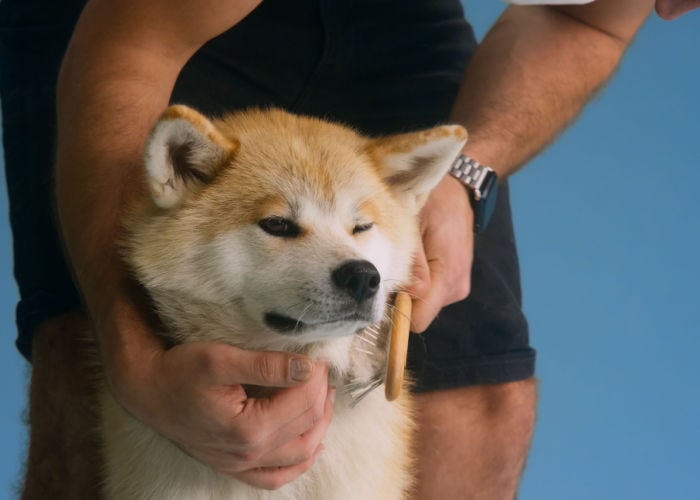
Use the right type of dog brush
There are several dog brushes available, but some are better for double-coated dogs than others.
When brushing your double-coated dog, you can use a variety of tools and methods to loosen potential dead hair, but here are groomer's recommendations:
Wire brush
Wire dog brushes are typically safe for all coat textures and lengths.
Much like a brush for human hair, this device features wire prongs that run through the hair, helping to detangle it.
Wire brushes may or may not have plastic or silicone beads at their tips, giving the brush a more comfortable sensation and being ideal for long coats as it won’t pull.
Bristle brush
Bristles are best for canines with a short length as they efficiently separate hair follicles, motivating blood flow and removing dead hair.
Silicone glove
Silicone prongs on the palm side of a grooming glove you wear may be more comforting to both you and your pet as it’ll feel like they’re enjoying a long petting session.
The rubbery texture of silicone is excellent at grabbing dead hair at the topcoat but not sufficient at loosening the undercoat and thus may be best suited for single-coated breeds rather than most double-coated dogs.
Shedding blade
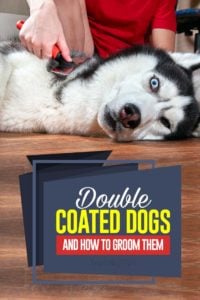 This oval-shaped, metal “brush” is specifically designed for breeds with long, fluffy coats.
This oval-shaped, metal “brush” is specifically designed for breeds with long, fluffy coats.
There are several de-shedding tools available, but the blade might be the best option for double-coated dogs.
However, it’s not recommended as a de-tangler, as it could get caught in hair clumps and painfully rip them out.
Tangles should be gently dissected before brushing occurs by delicately pulling them apart using your fingers.
Undercoat rake
A long-pronged brush typically made of metal will help you get well into the undercoat and sift through its denseness to find dead hair.
These are typically a must-have for owners of double-coated dog breeds.
Double-coated Dogs: FAQs
Still have questions about the double coat on your dog? We have answers.
What Happens If You Shave a Double-Coated Dog?
As mentioned, you should NEVER shave a dog with a double coat. This is because it can cause long-term damage.
Essentially, your dog's undercoat will regrow faster. It may even crowd out the guard hairs that grow more slowly.
This can lead to issues with your dog's coat's texture and color.
How Do You Know If Your Dog Is Double-Coated?
The easiest way to tell if your dog has a double coat is based on his breed. You can also tell by looking at the fur.
Dogs with a double coat will not have straight hair, but the undercoat will be soft. The fur also tends to be longer and denser.
If your dog has a single coat, it will typically be straight and soft.
Do Double-Coated Dogs Shed?
Yes, most dogs with double coats are shed twice every year. This is usually in the fall and the spring. During this time, they just shed their undercoat.
They also have regular shedding throughout the year, like any other breed.


